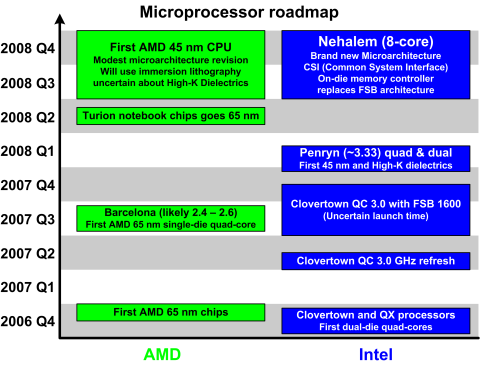Beyond AMD's Barcelona hype - the fine print

There's been a lot of hype lately coming from AMD about Barcelona, and it's been regurgitated throughout the Web. Even though no actual benchmarks were released, some of the following outrageous promises are being made:
- "We expect across a wide variety of workloads for Barcelona to outperform Clovertown by 40 percent," - Randy Allen, AMD's corporate vice president for server and workstation products. Source - ZDNet, 1/23/2007.
- Until now, the company has claimed that Barcelona will surpass the performance of Clovertown by about 40% at any given clock speed. Now the company says that it believes that Barcelona will have a 50% advantage over Clovertown in floating point applications and 20% in integer performance "over the competition’s highest-performing quad-core processor at the same frequency." Source - TGDaily 4/23/2007.
When I heard the 40% claim for "wide variety of workloads" back in January, I tried to verify with AMD if it was serious. I got the following statement back from an AMD spokesperson. [Note - Clovertown ran at 2.66 GHz at the time this quote was made, but Intel has come out with Clovertown 3.0 GHz]
Floating point - More than 40 percent over today’s highest performing Clovertown.
Integer - More than double digit advantage over today’s highest performing Clovertown.
We have not made any public statements regarding TPC-C. When we demonstrated Barcelona for the first time last November, we said that we would have an 80 percent performance advantage over AMD's current 2.8 GHz dual-core processors on OLTP, which is a database benchmark. But we never specifically called out TPC-C in any of our slides or official statements.
So if we examine this statement, AMD won't confirm its 40% "wide variety" claim since "double digit" advantage on Integer performance could mean as little as 10% or as high as 99%. But since it's claiming only an 80% boost with its new quad-core Barcelona over its existing 2.8 GHz dual-core Opteron, it's highly doubtful it will beat the Intel Clovertown 2.66 quad-core by 40% on integer performance or anywhere close.
Now if we look at its latest claim from yesterday, it seems to be inflating its numbers to 50% despite the fact that Intel has moved the bar on Clovertown performance even higher, to 3.0 GHz. That sounds outrageous on the face of it, but it makes sense when you look at the fine print of 20% better integer performance over Clovertown "at the same frequency." The problem here is that only the 50% number makes it to the headline, and the vast majority of people fail to see the fine print.
But now that AMD's saying that it'll win by 20% at the same clock speed over a Clovertown chip (most likely an 8-thread comparison on a dual-socket quad-core server), we can kind of make an educated guess of the performance advantage over a 2.66 GHz Clovertown processor to be roughly 16% on Integer benchmarks. I base this guess on the fact that ratio of 20:16 is the same as 50:40, but it's not a precise conversion since we're trying to deduce integer change from floating point change. This 16% guess is also only as good as the accuracy of the 20% clock-for-clock advantage claim.
However, we must now factor in the fact that Clovertown has already raised the clock speed to 3.0 GHz, which means Intel has boosted its clock speed 12.8%. Then we're likely to see another boost in the 1333 MHz FSB (Front Side Bus) for Clovertown to FSB 1600 MHz some time between now and the Penryn launch. So if AMD's hinted numbers are correct, AMD's Barcelona might end up with a slight lead of a few percentage points over Intel's Clovertown processors on Integer performance, which is in line with the roadmap I spelled out back in January. Here's an updated chart with some new products added to it.

AMD, with its huge financial troubles, margin erosion, and market share loss, has been desperate to come up with an answer to Intel's quad-core processors, which will have had an eight-month lead over Barcelona by the time Barcelona launches. If AMD Barcelona manages to pull off a small lead over Intel's Clovertown on most server workloads, which seems likely, it will help AMD hold on and possibly take back some market share in the highly profitable server market. There may be some danger with the exaggerated 40% and 50% hype, especially if AMD is claiming this is across a wide variety of workloads, because it might create some expectations that can't be met. But even if Barcelona launches on time and in quantity by the middle of this year, there may be only a six-month window of time before Intel strikes back hard with the 45nm Penryn chip. The race is definitely heating up.